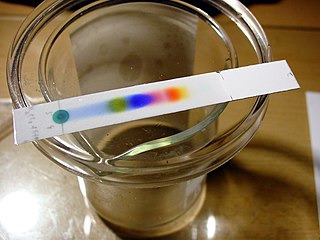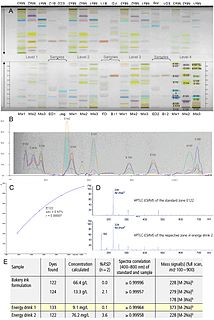
Analytical chemistry studies and uses instruments and methods used to separate, identify, and quantify matter. In practice, separation, identification or quantification may constitute the entire analysis or be combined with another method. Separation isolates analytes. Qualitative analysis identifies analytes, while quantitative analysis determines the numerical amount or concentration.
Chromatography is a laboratory technique for the separation of a mixture. The mixture is dissolved in a fluid called the mobile phase, which carries it through a structure holding another material called the stationary phase. The various constituents of the mixture travel at different speeds, causing them to separate. The separation is based on differential partitioning between the mobile and stationary phases. Subtle differences in a compound's partition coefficient result in differential retention on the stationary phase and thus affect the separation.

High-performance liquid chromatography is a technique in analytical chemistry used to separate, identify, and quantify each component in a mixture. It relies on pumps to pass a pressurized liquid solvent containing the sample mixture through a column filled with a solid adsorbent material. Each component in the sample interacts slightly differently with the adsorbent material, causing different flow rates for the different components and leading to the separation of the components as they flow out of the column.

Valdecoxib is a nonsteroidal anti-inflammatory drug (NSAID) used in the treatment of osteoarthritis, rheumatoid arthritis, and painful menstruation and menstrual symptoms. It is a selective cyclooxygenase-2 inhibitor. It was patented in 1995.

Piracetam is a drug marketed as a treatment for myoclonus and a cognitive enhancer. Evidence to support its use is unclear, with some studies showing modest benefits in specific populations and others showing minimal or no benefit. Piracetam is sold as a medication in many European countries. In the United States, piracetam is sold as a dietary supplement, despite being prohibited by the FDA.

Aniracetam, also known as N-anisoyl-2-pyrrolidinone, is a racetam which is sold in Europe as a prescription drug. It is not approved by the Food and Drug Administration for use in the United States.

Oxiracetam is a nootropic drug of the racetam family and a very mild stimulant. Several studies suggest that the substance is safe even when high doses are consumed for a long period of time. However, the mechanism of action of the racetam drug family is still a matter of research. Oxiracetam is not approved by Food and Drug Administration for any medical use in the United States.
Etiracetam is a chemical compound belonging to the racetam family, which was developed as a nootropic drug. It is racemic; its biologically active enantiomeric form is levetiracetam, now marketed as an antiepileptic drug.

Nebracetam is an investigational drug of the racetam family that is a M1 acetylcholine receptor agonist in rats. Its effects in humans have not been studied.

Column chromatography in chemistry is a chromatography method used to isolate a single chemical compound from a mixture. Chromatography is able to separate substances based on differential adsorption of compounds to the adsorbent; compounds move through the column at different rates, allowing them to be separated into fractions. The technique is widely applicable, as many different adsorbents can be used with a wide range of solvents. The technique can be used on scales from micrograms up to kilograms. The main advantage of column chromatography is the relatively low cost and disposability of the stationary phase used in the process. The latter prevents cross-contamination and stationary phase degradation due to recycling. Column chromatography can be done using gravity to move the solvent, or using compressed gas to push the solvent through the column.
Racetams are a class of drugs that share a pyrrolidone nucleus. Some, such as piracetam, are considered nootropics. Some such as aniracetam, oxiracetam, pramiracetam and phenylpiracetam are also nootropics. Others such as levetiracetam and seletracetam are anticonvulsants.

Thin-layer chromatography (TLC) is a chromatography technique used to separate non-volatile mixtures. Thin-layer chromatography is performed on a sheet of glass, plastic, or aluminium foil, which is coated with a thin layer of adsorbent material, usually silica gel, aluminium oxide (alumina), or cellulose. This layer of adsorbent is known as the stationary phase.

Phenylpiracetam, is a phenylated analog of the drug piracetam. It was developed in 1983 as a medication for Soviet Cosmonauts to treat the prolonged stresses of working in space. Phenylpiracetam was created at the Russian Academy of Sciences Institute of Biomedical Problems in an effort led by psychopharmacologist Valentina Ivanovna Akhapkina. In Russia it is now available as a prescription drug. Research on animals has indicated that phenylpiracetam may have anti-amnesic, antidepressant, anticonvulsant, anxiolytic, and memory enhancement effects.
Supercritical fluid chromatography (SFC) is a form of normal phase chromatography that uses a supercritical fluid such as carbon dioxide as the mobile phase. It is used for the analysis and purification of low to moderate molecular weight, thermally labile molecules and can also be used for the separation of chiral compounds. Principles are similar to those of high performance liquid chromatography (HPLC), however SFC typically utilizes carbon dioxide as the mobile phase; therefore the entire chromatographic flow path must be pressurized. Because the supercritical phase represents a state in which liquid and gas properties converge, supercritical fluid chromatography is sometimes called convergence chromatography.

High-performance thin-layer chromatography (HPTLC) is an enhanced form of thin-layer chromatography (TLC). A number of enhancements can be made to the basic method of thin-layer chromatography to automate the different steps, to increase the resolution achieved and to allow more accurate quantitative measurements.
Bioanalysis is a sub-discipline of analytical chemistry covering the quantitative measurement of xenobiotics and biotics in biological systems.

ABT-202 is a drug developed by Abbott, which acts as an agonist at neural nicotinic acetylcholine receptors and has been researched for use as an analgesic, although it has not passed clinical trials.

Polymer Char is a company which designs and manufactures instrumentation for polymer analysis.

A Chromatography column is a device used in chromatography for the separation of chemical compounds. A chromatography column contains the stationary phase, allowing the mobile phase to pass through it. Chromatography columns of different types are used in both gas and liquid chromatography.

Methylphenylpiracetam is a derivative of piracetam and a positive allosteric modulator of the sigma-1 receptor. It differs from phenylpiracetam by having a methyl group.















